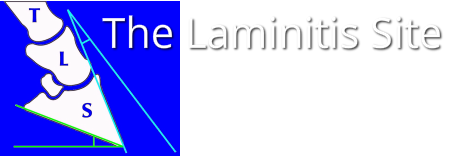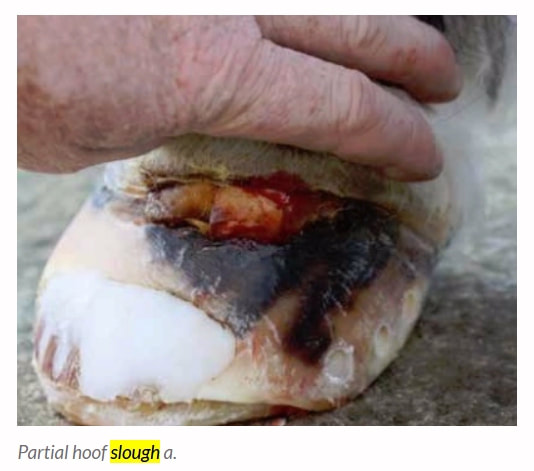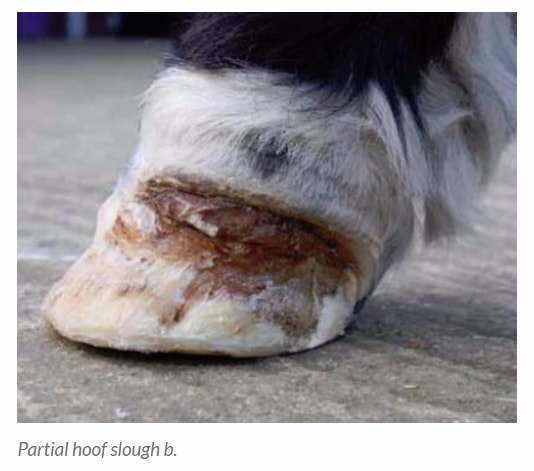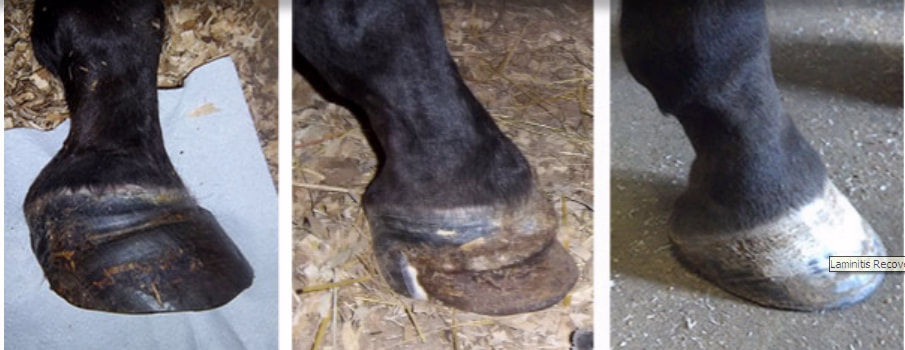DRAFT
The deep digital flexor tendon (DDFT) pulls upwards from its insertion site on the back of P3, with traction from wrapping around the navicular bone, and pushes the toe downwards. The force on the toe is increased when the toe is long. For active flexion of the DIP joint, the deep digital flexor muscle contracts, and this increases tension in the DDFT. Flexion of the DDFT is opposed by contraction of the common digital extensor muscles and the common digital extensor tendon, which inserts on the extensor process of P3. The DDFT lifts the palmar aspect of P3 and thereby moves the centre of pressure forwards (towards the toe) in relationship to the centre of rotation. Palmar rotation of P3 and having chronically high heels may lead to shortening/contraction of the DDFT. DDFT tension changes in horses with chronic laminitis, and pain from laminitis may also lead to changes in DDFT tension. Prolonged tension on the DDFT may contribute to reducing lamellar perfusion and increase shear forces on the dorsal lamellae. Ramsey et al. 2011 found, in an in vitro study, that elevating the heel up to 15 degrees might increase shearing forces on the dorsal lamellae.
A deep digital flexor tenotomy - cutting the deep digital flexor tendon (DDFT) - is sometimes recommended following laminitis when correct realigning trimming and support fails to realign the feet.
There are two recognized procedures - the DDFT can be cut either:
1. at the mid-metacarpal (the middle of the back of the canon bone) - less risk of complications, but less release of tension in the tendon is achieved, and possible risk of metacarpophalangeal joint (canon bone to P1) contraction;
2. at the palmar pastern (the back of the pastern) - increased risk of complications e.g. DIP joint subluxation, but also increased release of tension in the tendon.
DDF tenotomy is indicated in horses that have chronic phalangeal/bony rotation, i.e. a line through P2 and P3 is broken forwards, the distal interphalangeal (DIP) joint is abnormally flexed, and the palmar angle is higher than normal (>10 degrees), and correct realigning trimming to slowly lower the heels (without removing sole depth in the front of the foot if sole depth is insufficient) has been attempted but caused the horse to raise the heel (In this case, before considering a DDF tenotomy, ask whether the heels could have been lowered too quickly, replace heel material lost with padding, and if the horse can be made comfortable, try again to very slowly lower the heels, possibly aiming for 5 or more trims to lower the heels, and possibly making the initial aim (at the end of the 5 or more trims) around 8-10 degrees rather than the usual 3-5 degrees following laminitis). In some cases the fetlock joint may be abnormally flexed forwards with the horse walking on the toe of the foot, unable to lower the heels to the ground, even with abnormally high heels.
DDF tenotomy is not suitable for horses that have a negative palmar angle, or where lamellar connections in the back of the foot are compromised. The back of the foot should be stable before considering a DDT tenotomy.
Complications of DDF tenotomy include:
Opinions vary on how to manage the foot following a DDF tenotomy, and depend on which tenotomy method was used.
The back of the pastern tenotomy gives a greater release of tension in the DDFT but also creates increased instability in the DIP joint. Applying a shoe or device with a raised and possibly extended heel is recommended to prevent subluxation of the DIP joint.
Some vets recommend a shoe or device with a raised and possibly extended heel following the mid-cannon tenotomy as well.
Pressure wraps over the canon bone and long-term box rest (up to 3 months) may decrease the amount of scar tissue formation and thickening of the DDFT and reduce the risk of metacarpophalangeal joint contraction.
The deep digital flexor tendon (DDFT) pulls upwards from its insertion site on the back of P3, with traction from wrapping around the navicular bone, and pushes the toe downwards. The force on the toe is increased when the toe is long. For active flexion of the DIP joint, the deep digital flexor muscle contracts, and this increases tension in the DDFT. Flexion of the DDFT is opposed by contraction of the common digital extensor muscles and the common digital extensor tendon, which inserts on the extensor process of P3. The DDFT lifts the palmar aspect of P3 and thereby moves the centre of pressure forwards (towards the toe) in relationship to the centre of rotation. Palmar rotation of P3 and having chronically high heels may lead to shortening/contraction of the DDFT. DDFT tension changes in horses with chronic laminitis, and pain from laminitis may also lead to changes in DDFT tension. Prolonged tension on the DDFT may contribute to reducing lamellar perfusion and increase shear forces on the dorsal lamellae. Ramsey et al. 2011 found, in an in vitro study, that elevating the heel up to 15 degrees might increase shearing forces on the dorsal lamellae.
A deep digital flexor tenotomy - cutting the deep digital flexor tendon (DDFT) - is sometimes recommended following laminitis when correct realigning trimming and support fails to realign the feet.
There are two recognized procedures - the DDFT can be cut either:
1. at the mid-metacarpal (the middle of the back of the canon bone) - less risk of complications, but less release of tension in the tendon is achieved, and possible risk of metacarpophalangeal joint (canon bone to P1) contraction;
2. at the palmar pastern (the back of the pastern) - increased risk of complications e.g. DIP joint subluxation, but also increased release of tension in the tendon.
DDF tenotomy is indicated in horses that have chronic phalangeal/bony rotation, i.e. a line through P2 and P3 is broken forwards, the distal interphalangeal (DIP) joint is abnormally flexed, and the palmar angle is higher than normal (>10 degrees), and correct realigning trimming to slowly lower the heels (without removing sole depth in the front of the foot if sole depth is insufficient) has been attempted but caused the horse to raise the heel (In this case, before considering a DDF tenotomy, ask whether the heels could have been lowered too quickly, replace heel material lost with padding, and if the horse can be made comfortable, try again to very slowly lower the heels, possibly aiming for 5 or more trims to lower the heels, and possibly making the initial aim (at the end of the 5 or more trims) around 8-10 degrees rather than the usual 3-5 degrees following laminitis). In some cases the fetlock joint may be abnormally flexed forwards with the horse walking on the toe of the foot, unable to lower the heels to the ground, even with abnormally high heels.
DDF tenotomy is not suitable for horses that have a negative palmar angle, or where lamellar connections in the back of the foot are compromised. The back of the foot should be stable before considering a DDT tenotomy.
Complications of DDF tenotomy include:
- surgical errors damaging blood vessels,
- surgical errors damaging other tendons,
- post-surgery sepsis,
- making the back of the foot less stable,
- subluxation (partial dislocation) of the distal interphalangeal (DIP) joint (between P2 and P3) (more common following palmar pastern tenotomy),
- metacarpophalangeal joint contraction (more common following mid-metacarpal tenotomy).
Opinions vary on how to manage the foot following a DDF tenotomy, and depend on which tenotomy method was used.
The back of the pastern tenotomy gives a greater release of tension in the DDFT but also creates increased instability in the DIP joint. Applying a shoe or device with a raised and possibly extended heel is recommended to prevent subluxation of the DIP joint.
Some vets recommend a shoe or device with a raised and possibly extended heel following the mid-cannon tenotomy as well.
Pressure wraps over the canon bone and long-term box rest (up to 3 months) may decrease the amount of scar tissue formation and thickening of the DDFT and reduce the risk of metacarpophalangeal joint contraction.
References:
Ramsey GD, Hunter PJ, Nash MP
The effect of hoof angle variations on dorsal lamellar load in the equine hoof
Equine Vet J. 2011 Sep;43(5):536-42. doi: 10.1111/j.2042-3306.2010.00319.x
"The models in this study predict that raising the palmar angle increases the load on the dorsal laminar junction. Therefore, hoof care interventions that raise the palmar angle in order to reduce the dorsal lamellae load may not achieve this outcome."
Ramsey GD, Hunter PJ, Nash MP
The effect of hoof angle variations on dorsal lamellar load in the equine hoof
Equine Vet J. 2011 Sep;43(5):536-42. doi: 10.1111/j.2042-3306.2010.00319.x
"The models in this study predict that raising the palmar angle increases the load on the dorsal laminar junction. Therefore, hoof care interventions that raise the palmar angle in order to reduce the dorsal lamellae load may not achieve this outcome."




 RSS Feed
RSS Feed